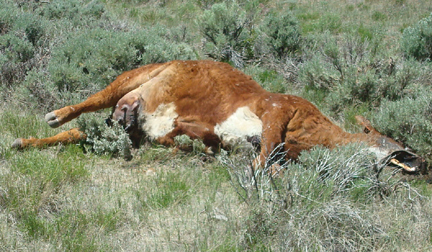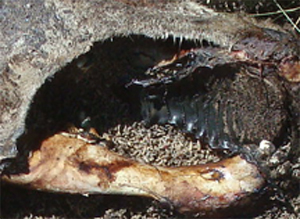June 25, 2010 at 01:20 PM
 An apparent San Luis Valley cattle mutilation was discovered off State Highway 285 by a passing motorist and passenger on June 19, 2010. The animal was located just north of mile marker 398 on the west side of the highway. The motorist was able to contact me and I went to the scene with investigator Saundra Marsh to document this potential case. I happened to be visiting the San Luis Valley on other business and was able to be on site in less than five hours. Because of time constraints, I was unable to conduct a thorough investigation of the report, but made a cursory 20-minute examination of the site and reported the case to the Conejos County Sheriff’s office. This latest potential case brings the total of reported unexplained livestock deaths and disfigurements in the greater San Luis Valley to 12 cows, two horses and one goat since November 2009.
An apparent San Luis Valley cattle mutilation was discovered off State Highway 285 by a passing motorist and passenger on June 19, 2010. The animal was located just north of mile marker 398 on the west side of the highway. The motorist was able to contact me and I went to the scene with investigator Saundra Marsh to document this potential case. I happened to be visiting the San Luis Valley on other business and was able to be on site in less than five hours. Because of time constraints, I was unable to conduct a thorough investigation of the report, but made a cursory 20-minute examination of the site and reported the case to the Conejos County Sheriff’s office. This latest potential case brings the total of reported unexplained livestock deaths and disfigurements in the greater San Luis Valley to 12 cows, two horses and one goat since November 2009.
The cow was lying on its left side, facing north, about 100 feet off the roadway and was missing the mandible flesh on the right side of its jaw. The cut was very precise and appeared to have been made by a sharp knife or scalpel. The denuded jawbone seemed unusually pale. There was clear evidence of cut hair follicles present on the backside of the mandible excision, and the topside of the mandible cut had unusual evidence of cut hair that alternated with 1/2 inch patches of uncut hair. I have never seen this type of alternating cut/uncut hair evidence before. No other organs were apparently excised, however a small coring of the female reproductive tract was evident as was bubbling body fluids in the wound. Abrasions were noted on the front right hock above the dew claw and high on the left rear hock. The dew claw on the left rear leg was missing. The unusual presence of uncoagulated blood was evident on the leg abrasions and tufts of hair were noted lying near the legs and belly of the cow.
Both Saundra and I suspect that the cow had been lifted by a harness and dropped. The cow had smashed down chico bushes that were splayed out around the hips from the impact. There was also what appeared to be an abrasion on the animal’s back above the right hip. The animal’s own tracks were not present and we did not note any globules of hemoglobin on the carcass.
 Close up of the mandible incision. Note apparent cut hair.
Close up of the mandible incision. Note apparent cut hair.
The animal was still bloated and blow fly maggots appeared to have hatched earlier that day which would place the probable date of the death and disfigurement to between June 12—15h. Scavengers had not touched the carcass; small birds we observed were reluctant to linger on the carcass for more than a couple of seconds and only a couple of small bird droppings were noted on the carcass. No evidence of magpies, crows, ravens or possible raptors were noted which is highly unusual for the SLV.
A cursory examination of the entire area around the cow revealed no predator or scavenger tracks, but a faint set of tire tracks were present. They approached to within 15 feet of the animal—approaching from the south. Two sets of footprints were noted (probably the initial witnesses who reported the case) but no footprints from the occupants of the vehicle were observed. The animal’s ear tag was intact which indicated that the rancher may not have been the occupant of the vehicle. (Ear tags are routinely taken off dead livestock by the rancher in order to document the animal that has died.) The immediate area around the cow appeared to be drier than the surrounding pastureland. This may have been due to mundane environmental conditions, but this observation is worth noting.
More on this case if it develops…
